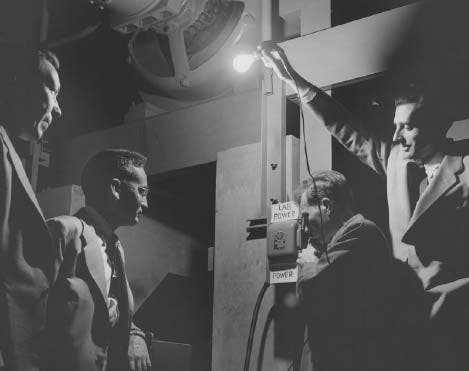The Manhattan Project
1943-1945
Hidden in remote cities and factories across the United States, scientists and ordinary citizens work in secrecy to produce the hardware and fissionable material to build an atomic bomb.
January 1943
Construction began along the Columbia River at Hanford, Washington, to build a facility to produce plutonium for an atomic bomb. General Groves chose the DuPont Company as the prime construction contractor. DuPont officials selected Hanford because of its great distance from the uranium production facility at Oak Ridge, Tennessee and its proximity to a major water source.
March 1943
J. Robert Oppenheimer arrived at the new atomic research labortory at Los Alamos, New Mexico. Los Alamos satisfied two key requirements for the secret project: safety from bombing by enemy aircraft and safety from curious citizens.
June 1945
Prominent scientists involved in the Manhattan Project delivered “A Report of the Committee on Political and Social Problems from the Manhattan Project’s Metallurgical Laboratory at the University of Chicago” to Secretary of War Henry Stimson. The Franck Report, named after the committee chairman James Franck and signed by fellow scientists Donald Hughes, J. J. Nickson, Eugene Rabinowitch, Glenn Seaborg, J. C. Stearns, and Leo Szilard, urged the Truman administration to use an atomic bomb demonstration with the Japanese in a remote area instead of against a civilian population.
July 16, 1945
Manhattan Project scientists exploded the world’s first atomic bomb one hundred feet over an area of New Mexico desert known as the Jornada del Muerto, the Journey of the Dead Man. After witnessing the explosion, physicist Kenneth Bainbridge, the Trinity Test Director, said to Oppenheimer, “now we are all sons of bitches.”
August 6, 1945
The United States Army Air Force dropped an atomic bomb on Hiroshima, Japan. The bomb, named “Little Boy,” used uranium-235 processed at Oak Ridge for its implosion assembly. This was followed three days later with a second atomic bomb, “Fat Man,” dropped on Nagasaki. World War II officially ended on September 2 with the formal surrender ceremony in Tokyo Harbor.

